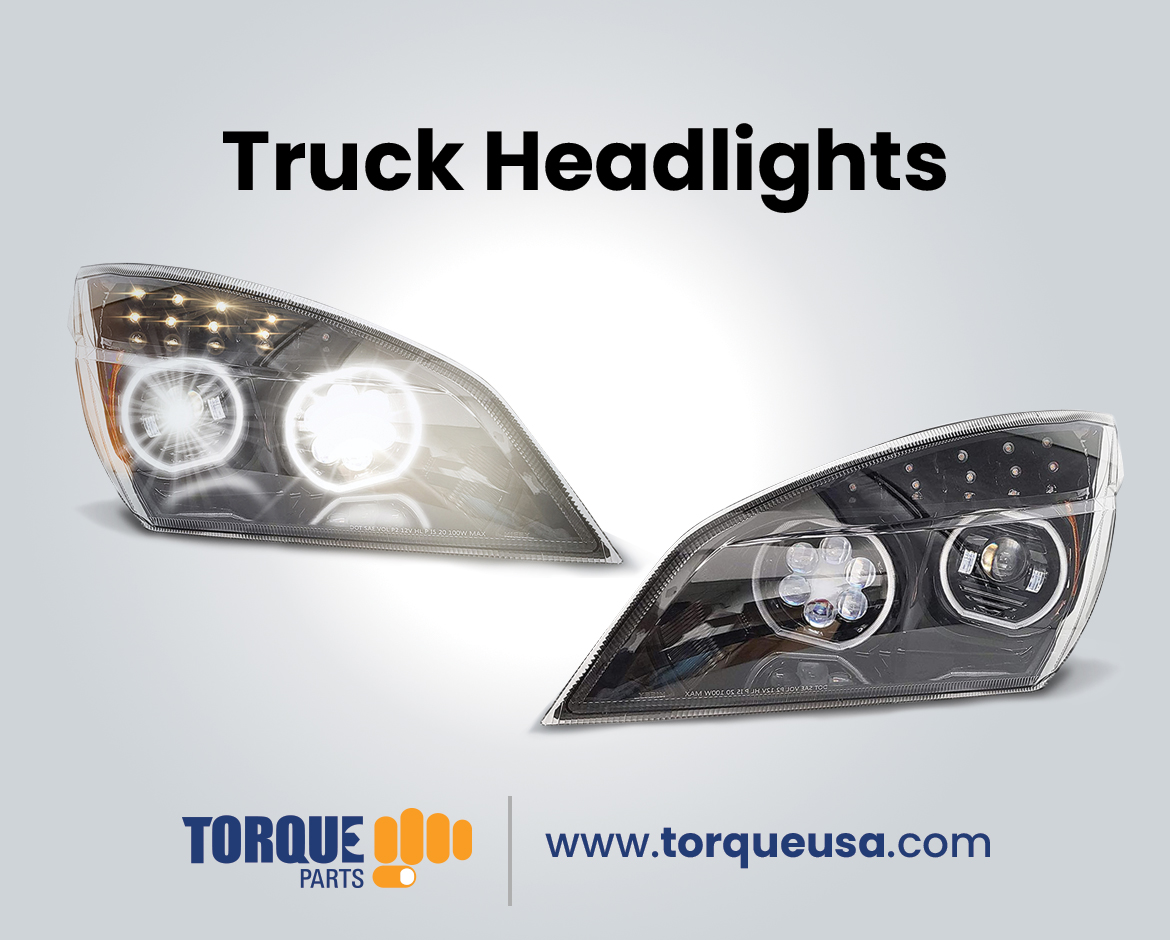
Illuminating the Road Ahead A Guide to Truck Headlights Brightening Paths
Introduction to Truck Headlights
Truck headlights are more than just sources of illumination; they are essential components that ensure safety and visibility on the road. In this chapter, we delve into the multifaceted role of truck headlights and their significance in enhancing the driving experience. From the evolution of headlight technology to their impact on road safety, we explore the broader context surrounding these crucial automotive elements.
Truck headlights have come a long way from conventional halogen bulbs to modern LED and HID technologies. Understanding this evolution provides insight into the advancements that have revolutionized visibility and safety for truck drivers.
Moreover, we’ll discuss how proper illumination not only illuminates the road ahead but also contributes to reducing accidents and enhancing overall driving comfort. By shedding light on the importance of truck headlights, we set the stage for a deeper exploration of their functionality, benefits, and considerations in subsequent chapters.
Join us as we embark on a journey to uncover the intricacies of truck headlights and discover how they pave brighter paths for drivers navigating the roads ahead.
The Science Behind Headlight Brightness
Understanding the scientific principles behind headlight brightness is crucial for appreciating their impact on road safety and visibility. In this chapter, we delve into the intricate mechanisms that determine the luminosity, color temperature, and beam patterns of truck headlights.
Luminosity, measured in lumens, defines the brightness emitted by a headlight. We’ll explore how different types of headlights, such as halogen, LED, and HID, vary in their luminosity and how this affects visibility on the road.
Color temperature, measured in Kelvin (K), influences the perceived color of light emitted by headlights. We’ll discuss the significance of color temperature in terms of visibility and contrast, helping readers understand how it impacts their driving experience.
Beam patterns play a crucial role in directing light onto the road while minimizing glare for oncoming drivers. We’ll examine the differences between low beam and high beam patterns and how they adapt to different driving conditions.
By unraveling the science behind headlight brightness, readers gain valuable insights into how these technical aspects contribute to safer and more efficient driving. Armed with this knowledge, truck owners can make informed decisions when selecting headlights that best suit their needs and preferences. Join us as we illuminate the path to understanding the science behind headlight brightness.
Types of Truck Headlights
In this chapter, we explore the diverse array of truck headlights available in the market, each offering unique features and benefits. From traditional halogen bulbs to cutting-edge LED and HID technologies, truck owners have a wide range of options to consider.
Halogen headlights, known for their affordability and widespread availability, remain a popular choice among truck owners. We’ll discuss their characteristics, including luminosity and longevity, as well as their limitations compared to newer technologies.
LED headlights have gained prominence in recent years due to their energy efficiency, durability, and superior brightness. We’ll delve into the advantages of LED headlights, such as their instant illumination and customizable designs, making them an appealing option for truck enthusiasts.
HID headlights, characterized by their intense brightness and distinct bluish-white light, offer an alternative to traditional halogen and LED options. We’ll explore the technology behind HID headlights and discuss their benefits and considerations for truck owners.
Additionally, we’ll touch upon specialty headlights, such as adaptive headlights and projector headlights, which further enhance visibility and safety on the road.
By understanding the characteristics of different types of truck headlights, readers can make informed decisions when upgrading or replacing their vehicle’s lighting system. Join us as we illuminate the path to selecting the perfect headlights for your truck.
Benefits of Upgrading to Brighter Headlights
In this chapter, we explore the numerous advantages that come with upgrading to brighter headlights for trucks. While the decision to upgrade may seem daunting, the benefits far outweigh the initial investment.
Enhanced visibility is perhaps the most significant advantage of upgrading to brighter headlights. With increased luminosity and better beam patterns, drivers can see farther down the road and detect potential hazards sooner, thus reducing the risk of accidents, especially in low-light conditions.
Improved safety is another compelling reason to upgrade headlights. Brighter headlights make the vehicle more visible to other drivers, pedestrians, and cyclists, reducing the likelihood of collisions. Moreover, advanced technologies such as adaptive headlights can adjust their beams to accommodate varying road conditions and improve overall safety.
Upgrading to brighter headlights also enhances driving comfort. Clearer visibility reduces eye strain and fatigue, particularly during long nighttime drives. Additionally, the aesthetic appeal of brighter headlights can enhance the overall look of the truck, adding a touch of style and sophistication.
Moreover, brighter headlights often come with increased durability and longevity, saving truck owners time and money on frequent replacements.
By upgrading to brighter headlights, truck owners can enjoy a safer, more comfortable, and visually appealing driving experience. Join us as we delve deeper into the benefits of upgrading headlights and how they can transform your truck’s performance on the road.
Factors to Consider When Choosing Truck Headlights
Selecting the right headlights for your truck involves considering various factors to ensure optimal performance and compatibility. In this chapter, we’ll explore key considerations that truck owners should keep in mind when choosing headlights for their vehicles.
Brightness and luminosity are essential factors to consider when selecting truck headlights. Different types of headlights offer varying levels of brightness, measured in lumens. Understanding the required brightness for your driving needs and environment is crucial for making an informed decision.
Durability is another critical factor, especially for trucks that frequently traverse challenging terrain or adverse weather conditions. Headlights with robust construction and weather-resistant features can withstand the rigors of off-road driving and prolonged exposure to harsh elements.
Compatibility with your truck’s electrical system is vital to ensure seamless integration and functionality. Before purchasing headlights, check compatibility with your vehicle’s make and model, as well as any additional wiring or adapters required for installation.
Regulatory compliance is essential to ensure that the chosen headlights meet legal requirements and standards. Different regions have specific regulations regarding headlight brightness, beam patterns, and color temperatures. Ensure that the headlights you choose comply with local regulations to avoid fines or legal issues.
Finally, consider factors such as ease of installation, warranty coverage, and aftermarket support when selecting truck headlights. Opting for headlights from reputable manufacturers with a track record of quality and customer satisfaction can provide peace of mind and assurance of reliability.
By considering these factors when choosing truck headlights, you can make a well-informed decision that meets your specific requirements and enhances your driving experience. Join us as we navigate through the essential considerations for selecting the perfect headlights for your truck.
Installation and Maintenance of Truck Headlights
Proper installation and maintenance of truck headlights are essential for ensuring optimal performance and longevity. In this chapter, we’ll guide you through the process of installing and maintaining your truck headlights to maximize their efficiency and reliability.
Installation:
- Gather Necessary Tools
: Before beginning the installation process, gather the necessary tools, including screwdrivers, pliers, and electrical tape, to ensure a smooth installation. - Follow Manufacturer’s Instructions: Carefully read and follow the manufacturer’s instructions provided with the headlights to ensure correct installation. Pay attention to any specific steps or precautions outlined in the manual.
- Disconnect the Battery: For safety purposes, disconnect the truck’s battery before starting the installation process to prevent electrical accidents or damage to the vehicle’s electrical system.
- Remove Old Headlights: Remove the old headlights carefully, taking note of any wiring or mounting brackets that need to be detached. Clean the headlight mounting area to remove any dirt or debris.
- Install New Headlights: Install the new headlights according to the manufacturer’s instructions, ensuring that all wiring connections are secure and properly insulated. Test the headlights to ensure they are functioning correctly before reattaching any mounting brackets or panels.
Maintenance:
- Regular Cleaning: Keep your truck headlights clean by regularly washing them with mild soap and water to remove dirt, bugs, and road grime. Avoid using abrasive cleaners or rough materials that could scratch the headlight lens.
- Inspect for Damage: Periodically inspect your truck headlights for any signs of damage, such as cracks, moisture buildup, or discoloration. Address any issues promptly to prevent further damage and ensure continued visibility on the road.
- Replace Bulbs as Needed: If you notice dimming or flickering headlights, it may be time to replace the bulbs. Follow the manufacturer’s recommendations for bulb replacement intervals and choose high-quality replacement bulbs for optimal performance.
- Check Alignment: Ensure that your truck headlights are properly aligned to provide maximum visibility without causing glare for other drivers. Adjust the headlight alignment as needed to maintain optimal performance.
By following these installation and maintenance tips, you can ensure that your truck headlights remain in top condition, providing reliable illumination and enhancing safety on the road. Join us as we illuminate the path to proper installation and maintenance of truck headlights.
Cost Considerations and Budget-Friendly Options for Truck Headlights
Understanding the cost implications of upgrading truck headlights is crucial for budget-conscious consumers. In this chapter, we explore various cost considerations and budget-friendly options available to truck owners seeking to enhance their vehicle’s lighting system without breaking the bank.
Cost Considerations:
- Initial Investment
: The initial cost of purchasing and installing new truck headlights can vary depending on factors such as the type of headlights, brand, and installation complexity. LED and HID headlights typically have a higher upfront cost compared to halogen bulbs but may offer long-term savings due to their energy efficiency and longevity. - Operating Costs: Consider the long-term operating costs associated with different types of headlights, including maintenance, replacement bulbs, and energy consumption. LED headlights, for example, have lower energy consumption and longer lifespan, potentially reducing overall operating costs over time.
- Additional Accessories: Factor in any additional accessories or upgrades, such as wiring harnesses, mounting brackets, or aftermarket covers, when estimating the total cost of upgrading truck headlights.
Budget-Friendly Options:
- Halogen Bulbs: Traditional halogen bulbs remain a cost-effective option for truck owners on a budget. While they may not offer the same level of brightness or energy efficiency as LED or HID headlights, halogen bulbs provide adequate illumination at a lower initial cost.
- Aftermarket Kits: Explore aftermarket headlight conversion kits designed to upgrade existing headlights to LED or HID technology. These kits often provide a more affordable alternative to purchasing new headlights while still offering improved performance and visibility.
- Sales and Discounts: Keep an eye out for sales, promotions, and discounts offered by automotive retailers and online vendors. Purchasing headlights during promotional periods or utilizing coupons can help reduce the overall cost of upgrading truck headlights.
- DIY Installation: Consider installing the headlights yourself to save on installation costs. Many truck owners with basic mechanical skills can successfully install aftermarket headlights using simple tools and step-by-step instructions provided by the manufacturer.
By carefully considering cost factors and exploring budget-friendly options, truck owners can upgrade their headlights to enhance visibility and safety on the road without exceeding their budgetary constraints. Join us as we illuminate cost-effective solutions for upgrading truck headlights.
Future Trends in Truck Headlight Technology
In this final chapter, we explore the exciting future trends and advancements in truck headlight technology. As automotive technology continues to evolve, so too do the capabilities and features of truck headlights. Join us as we peer into the future of illumination on the road.
LED and OLED Integration:
LED technology has already made significant strides in the automotive industry, offering superior brightness, energy efficiency, and longevity. Looking ahead, we anticipate further integration of LED and OLED (Organic Light-Emitting Diode) technologies in truck headlights. OLED headlights offer flexibility in design and enhanced lighting performance, paving the way for innovative lighting solutions in future truck models.
Adaptive Lighting Systems:
Adaptive lighting systems, equipped with sensors and cameras, dynamically adjust headlight beams based on driving conditions, vehicle speed, and surrounding environment. These systems can enhance visibility while minimizing glare for oncoming drivers, ultimately improving safety on the road. We anticipate widespread adoption of adaptive lighting systems in future truck models, offering drivers unprecedented control and customization over their headlights.
Connectivity and Smart Features:
With the rise of connected vehicles and IoT (Internet of Things) technology, truck headlights are poised to become more intelligent and interconnected. Future headlights may feature advanced connectivity features, allowing them to communicate with other vehicles, traffic signals, and navigation systems. Smart features such as automatic high-beam control, lane-specific lighting, and pedestrian detection could further enhance safety and convenience for truck drivers.
Sustainable Lighting Solutions:
As environmental concerns continue to shape automotive design, we expect to see a shift towards more sustainable lighting solutions for trucks. Manufacturers may explore alternative materials and manufacturing processes to reduce the environmental impact of headlight production. Additionally, advancements in energy-efficient lighting technologies, such as solar-powered headlights and regenerative lighting systems, could further contribute to sustainability efforts in the automotive industry.
Conclusion:
The future of truck headlight technology is bright, with advancements in LED integration, adaptive lighting systems, connectivity, and sustainability driving innovation in the automotive industry. As these technologies continue to evolve, truck owners can look forward to safer, smarter, and more sustainable lighting solutions that illuminate the road ahead with unprecedented clarity and efficiency. Join us as we embark on a journey into the future of truck headlight technology.
For detailed information, you can contact us at: Truck Headlights



